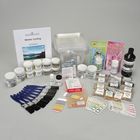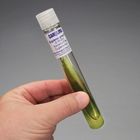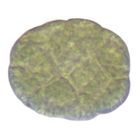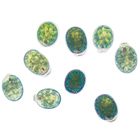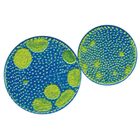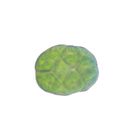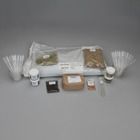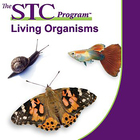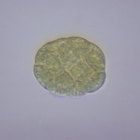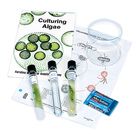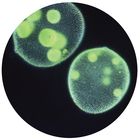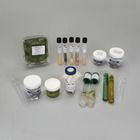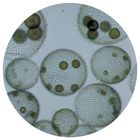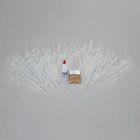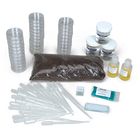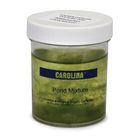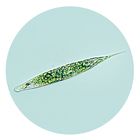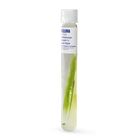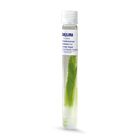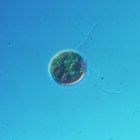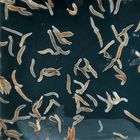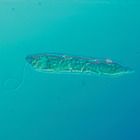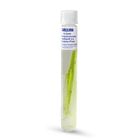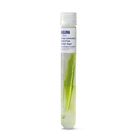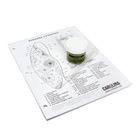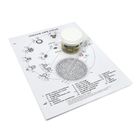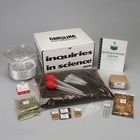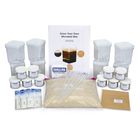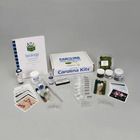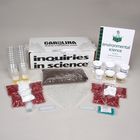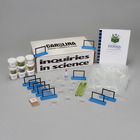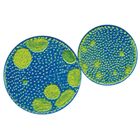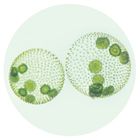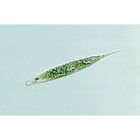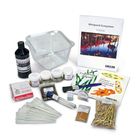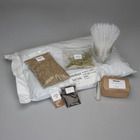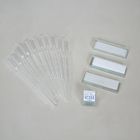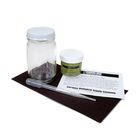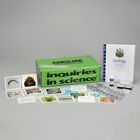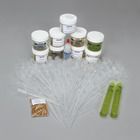Care Guide: Protists
Living Care Information
Protists
Quick Start Information
Open the shipping container. Remove and inspect the jar of protists. Unscrew the lid.
Aerate the culture to help replace the oxygen depleted during shipping. To aerate, use the plastic pipette supplied with each culture. Place the pipette tip into the culture water and squeeze the bulb, bubbling air into the water. Withdraw the pipette and release the bulb, allowing it to refill with air. Repeat 4 more times.
If you have more than one culture, use a different pipette for each one to avoid contamination.
Replace the lid on the culture jar, but do not screw it tight.
Keep the culture jar at room temperature (about 21 °C, or 70 °F) and out of direct sunlight.
About the Organism
- Protists include protozoa and other eukaryotes with plant-like characteristics.
- Protists chiefly reproduce by cell division.
- Protists are microscopic. A few of the larger ones are barely visible to the unaided eye.
- Protists are frequently cosmopolitan. The same species are found on all continents.
- Domain: Eukarya
- Kingdom: Protista (historical)
Preparation
Allow 15 to 20 minutes after aeration for the organisms to settle. Inspect the culture using a stereomicroscope and low illumination. Using the stereomicroscope will allow you to pinpoint the areas where the organisms are concentrated. These are the areas where students should obtain their samples when preparing slides for viewing. Using the stereomicroscope and designated pipette for that culture, students can pick out a single organism (or group of organisms) for their individual slides.
Many protozoa (such as Paramecia) concentrate in areas where food particles are abundant. These areas are visible as fuzzy debris within the culture.
Amoebas can be difficult to locate at first because they move slowly and lack a constant shape. To find them, focus on the bottom of the jar after it has been sitting undisturbed for at least 15 minutes. Watch through the stereomicroscope for a few seconds. You should begin to see dozens of Amoebas as they creep slowly over the bottom. You will also see smaller, faster moving organisms, Chilomonas, swimming about in the Amoeba culture. Chilomonas serve as a food source for the Amoebas. See our How to Find Your Amoeba video for more information.
For most lab uses, students should make a wet mount preparation for viewing under a microscope. To pick up an organism (or organisms), squeeze the pipette bulb before inserting the pipette tip into the culture. Release the bulb when the pipette’s tip is close to where the protozoa are concentrated. Keep the pipette vertical as you are drawing the sample to avoid stirring up the culture and scattering the organisms. Do not squirt the pipette water back into the culture for the same reason. One drop should contain more than enough organisms for a wet mount. After adding a coverslip, examine the slide using the microscope’s lowest magnification. After you locate the protozoa, use high magnification to observe the organisms in greater detail. Some protozoa, mainly ciliates, move so rapidly that it can be difficult to keep them in the field of view under high-power magnification. A quieting solution such as Protoslo® slows the ciliates’ movement without killing them. Add 1 drop of Protoslo® quieting solution to a drop of culture on a slide, mix well, add a coverslip, and observe.
Housing
No housing information applies for this organism.
Feeding
No feeding information applies for this organism.
Maintaining and culturing
Photosynthetic protists (Euglena and Volvox) need light to manufacture their own food. Use either indirect natural light or a light bank (such as our plant light bank) to provide light for these organisms. Never place cultures in a refrigerator or in direct sunlight. Maintain cultures at room temperature (about 21 °C or 70 °F), with the lid placed lightly over the mouth of the jar. Plan to use the culture as soon after receipt as possible. Many protozoa are easily cultured. For instructions on how to culture, refer to the Carolina® Protozoa and Invertebrate Manual.
Disposal
When you are finished with your cultures, they can be added to an aquarium where they will serve as food for small fish. You can also dispose of them by pouring them down a sink, followed by a flush of a gallon of water. The chlorine in most tap water will kill protists. If your water supply comes from a well, your water may not be chlorinated. If that is the case, add 1 mL (20 drops) of household bleach or alcohol to the jar. Allow the jar to stand for 15 minutes before disposal.
Biosafety
None of the protists supplied by Carolina are pathogenic or parasitic. Our technicians have worked with these organisms for many decades without problems. We recommend that you wash and dry your hands after working with any microorganism.
Video
FAQs
How long can I keep my cultures before using them?
It is always best to use protozoan cultures within a few days of receipt. With simple care, most will last for 5–7 days. Some cultures last longer than others. Euglena and Paramecium cultures, for example, tend to be long-lived, but Volvox is not. If in doubt, examine your culture under a stereomicroscope to see if it is still useable.
My cultures arrived on a Friday. Can I keep them over the weekend and use them for class on Monday?
Remove the cultures from their shipping container, and care for them as directed above. Do not leave your cultures in the unopened shipping container. Photosynthetic forms need light. Heterotrophic forms are shipped with enough food in their jar to maintain the culture for an extended period. You may even find that the cultures improve when left over the weekend because they have had time to recover from the shipping process.
My students are not finding any protozoa. What should I do?
Ensure students are following the sampling procedures described in the Preparation section. Protozoan species differ greatly in size. If students have previously observed larger protozoa, such as Paramecia, remind them to look for smaller organisms when searching for Euglena. Finally, examine the culture under a stereomicroscope to locate areas where protozoa are concentrated, and direct students to collect samples from those areas.
We used Protoslo® quieting solution, but now all the protozoa are at the edge of the coverslip and some have even been squeezed out from under the coverslip. What can I do?
If the Protoslo® solution and culture water are not thoroughly mixed, the thicker solution will displace the water and protozoa when the coverslip is added. If this occurs, clean the slide and start over. Be sure to thoroughly mix the Protoslo® solution and culture water before adding the coverslip to the slide.
Need help?
We want you to have a good experience. Orders and replacements: 800.334.5551, then select Customer Service. Technical support and questions: caresheets@carolina.com



